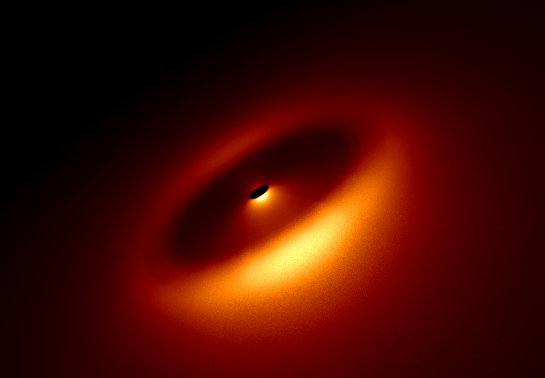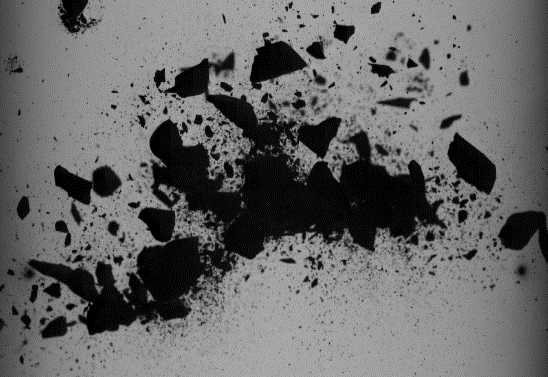About FOR 2285
Debris Disks in Planetary Systems
The Research Unit focuses on debris disks, dusty belts of comets and asteroids around stars. Like planets, these disks are a natural outcome of planet formation processes. They are able to tell us a lot about the history and architecture of planetary systems.
 |
 |
| A synthetic scattered-light image of a debris disk, based on theoretical models (Credits: Löhne, AIU/FSU Jena). The observed emission stems from numerous micrometer-sized dust grains generated in collisions of larger bodies. | A cloud of such collisional fragments seen in a laboratory impact experiment (Credit: Blum, IGeP/TU Braunschweig). |
The Research Unit is a collaborative effort of several institutes of the University of Jena, Technical University of Braunschweig, University of Kiel, and the Hamburg Observatory. We employ state-of-the-art theoretical and laboratory methods to deeply analyze a wealth of observational data available and to prepare future observations of debris disks.
Summary
The Research Unit FOR 2285 was established in 2015 to investigate debris disks - belts of comets, asteroids, and their dust around main-sequence stars. During the first phase, we carried out analytic and numerical modeling of their collisional and dynamical evolution. In parallel, we conducted impact experiments to simulate collisional processes and performed laboratory studies of the optical properties of dust and its interaction with stellar radiation. Combining the theoretical and laboratory results, we have produced detailed models that explain the observations of individual disk systems and explored statistics over larger samples, giving us new insights into a variety of puzzles including the origin of debris disks and the composition of their dust. Furthermore, we have conducted and published our own new observations of key planetary systems. Our research is already being utilised by and inspiring the community and is delivering testable predictions for future observations.
The second phase of the Research Unit will build on our successes from the first phase, whilst also incorporating some new lines of research. On the theory side, we will address both long-standing problems, such as the origins of warm and hot dust and determining what causes disk asymmetries, as well as new ones that we have identified through our research in the first phase, such as the 'disk mass problem'. On the laboratory side, we will benefit from the setups that we have put into operation and from the experience gained in the first phase to produce realistic dust analogs and determine their collisional and optical properties in parameter spaces that have not previously been investigated. With laboratory results now coming in, we will advantageously incorporate them into the theoretical models to meet the Research Unit objectives. The primary goal of the Research Unit is to better understand the properties, physics, and diversity of debris disks and what they tell us about the architecture, formation, and evolution of planetary systems.
Coordination
| Spokesperson: | Prof. Dr. Alexander Krivov | (AIU, Friedrich-Schiller-University Jena) |
| Deputy Spokesperson: | Prof. Dr. Sebastian Wolf | (ITAP, Christian-Albrechts-University Kiel) |
| Secretary: | Annett Weise | (AIU, Friedrich-Schiller-University Jena) |
| System administrator: | Dr. Frank Gießler | (AIU, Friedrich-Schiller-University Jena) |
Institutes
- AIU, Friedrich-Schiller-University Jena
- IAP, Friedrich-Schiller-University Jena
- IFK, Friedrich-Schiller-University Jena
- IGW, Friedrich-Schiller-University Jena
- ITAP, Christian-Albrechts-University Kiel
- IGeP, Technical University Braunschweig
- Hamburg Observatory
Projects and people
Phase 1 (2015−2019)
Project P1: Collisional modeling of resolved debris disks (AIU/Jena)
Project P2: Sculpturing of debris disks by planets and companions (AIU/Jena)
Project P3: Origin of warm and hot dust and planetary system architecture (AIU/Jena)
Project P4: Observational appearance of debris disks (ITAP/Kiel)
Project P5: Dust opacity measurements for debris disks (AIU/Jena)
Project P6: Mechanical properties of solids in debris disks from impact experiments (IGeP/Braunschweig)
Project P7: Laser-based simulations of collisions and the structural state of dust (IGW/IAP/Jena)
Project P8: Ice-silicate-carbon mixtures in stellar UV fields (IFK/Jena)
Project P9: Photospheric and chromospheric models of debris disk host stars (Hamburg Observatory)
Project Z: Coordination (AIU/Jena)
Phase 2 (2019−2023)
Project P1: Masses and stirring of debris disks (AIU/Jena)
Project P2: Sculpturing of debris disks by planets and companions (AIU/Jena)
Project P3: Origin of warm and hot dust and planetary system architecture (AIU/Jena)
Project P4: Observational appearance of debris disks (ITAP/Kiel)
Project P5: Dust opacity measurements for debris disks (AIU/Jena)
Project P6: Collision properties of solids at low to moderate impact velocities (IGeP/Braunschweig)
Project P7: Impact experiments at high speeds and fragment distributions (IGW/Jena)
Project P8: Temperature-dependent photostability and optical properties of realistic cometary ice composites (IFK/Jena)
Project Z: Coordination (AIU/Jena)
| Contact: | Professor Alexander Krivov |
| See also: | DFG press release |
| FSU/Jena press release | |
| DFG press release (Phase 2) | |
| FSU/Jena press release (Phase 2) | |
| FSU/Jena announcement of Phase 2 |